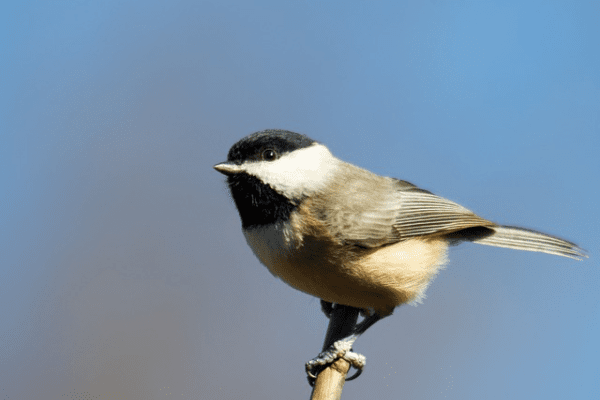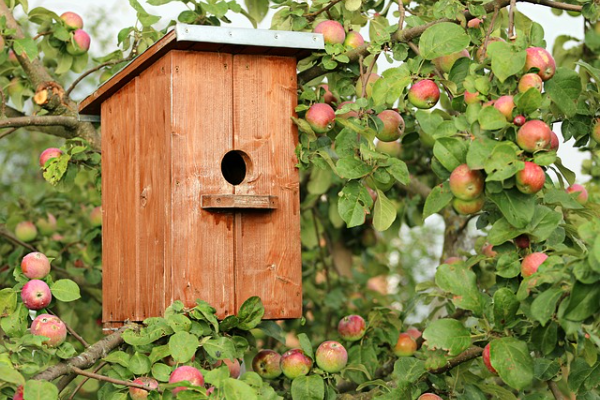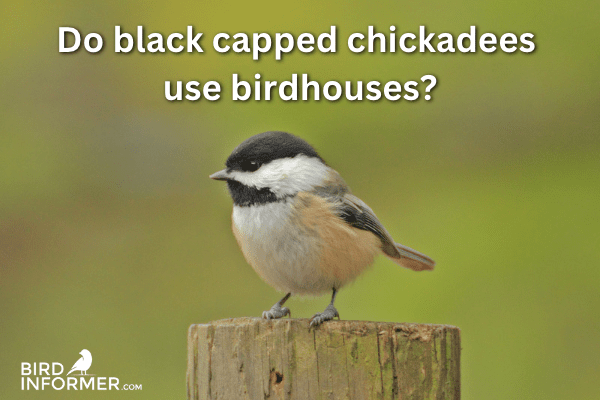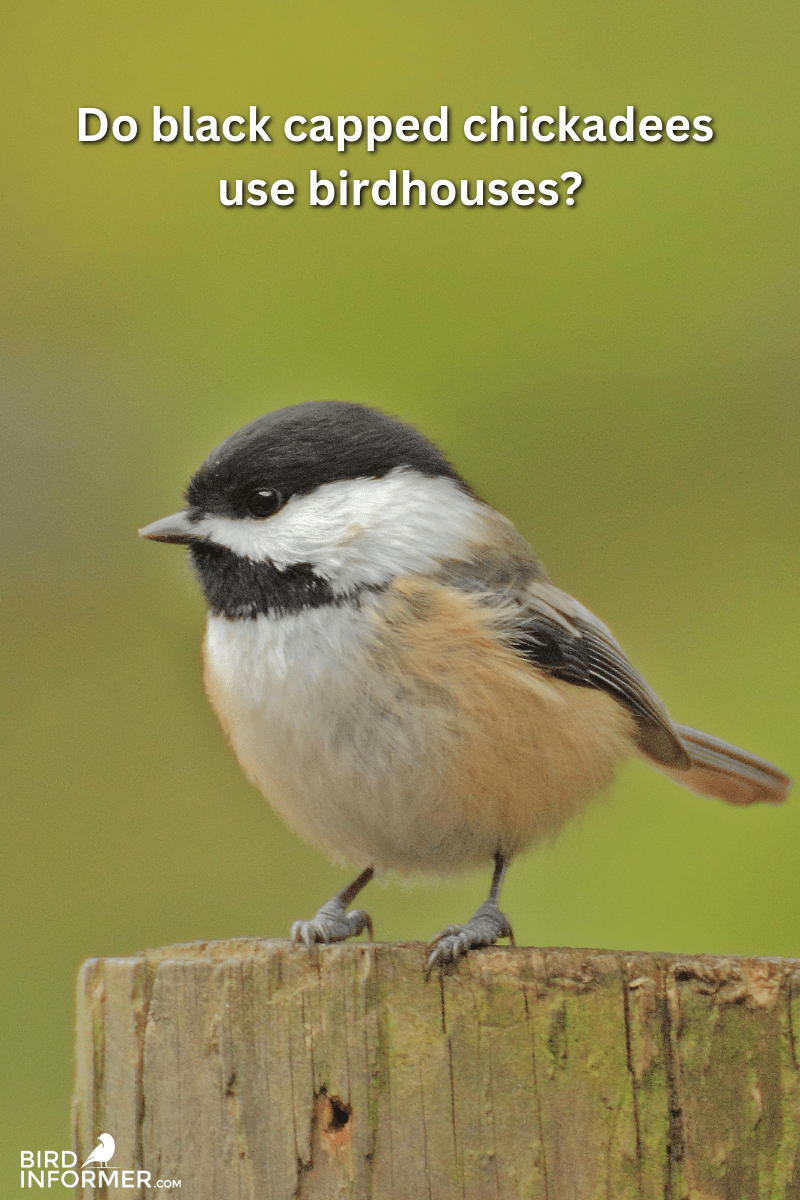Contents
- General Information
- Nesting Preferences
- How to Build a Black-Capped Chickadee Birdhouse
- When Is the Best Time to Hang up a Black Capped Chickadees Birdhouse?
- What Is The Best Location To Mount This Birdhouse?
- Should Anything Be Put Inside?
- Is It Absolutely Necessary to Put Holes at the Bottom of the Chickadee Birdhouse?
- Do Chickadees Like Painted Birdhouses?
Are you trying to learn more about the nesting habits of Black-capped chickadees? Do you wonder if this North American songbird is willing to take up residence in a birdhouse? Keep reading to find out the truth of the matter and so much more.
Black-capped chickadees are cavity-nesting birds. They’re willing to live in birdhouses or roosting boxes, which is good news for homeowners looking to entice them into their backyards. To attract them, mount a chickadee house directly to a pole or wall anywhere from 4-15 feet off the ground.
In a moment, I’d like to share the specific details about Black-capped chickadees and whether or not they like to use birdhouses. I’ll also share important information with you regarding these beautiful songbirds today. I’ll cover topics that include:
- Their nesting preferences
- How to build a birdhouse that they’d like
- When you should hang up a chickadee birdhouse
- Where you should hang a chickadee birdhouse
- And other important information
To find out the full scoop on the information mentioned above and much more, please continue reading to learn about these important and valuable topics.
General Information
In the United States of America, the black-capped Chickadee is one of the more familiar and popular birds. It’s very active and quite recognizable throughout the United States.
Its wingspan measures 6-8 inches, its body measures 5-6 inches, and it weighs between 9-14 g. It’s a relatively small songbird, but it’s beautiful nonetheless and it’s a regular stable throughout backyards all through the United States.
It shouldn’t surprise anyone to learn that the feathers on top of its head are black, which is why it’s considered a black-capped Chickadee. It also has a back black bib underneath its beak and neck area, which is an attractive distinguishing feature.
When looking at its wings, you’ll notice a dark gray color within. But the edges of the wings are covered in white feathers.
On the other hand, the tale of the black-capped Chickadee is relatively long. It possesses the same gray color structure as the wings, except it doesn’t have white edging. Juvenile black-capped chickadees possess the same look as their parents and males and females also have very similar looks.
Nesting Preferences

As far as nesting preferences are concerned, the black-capped chickadee specifically likes to live in areas that have lots of woods including cotton groves, willow thickets, and parks with winds in them. The black-capped Chickadee will use rotted tree stumps or holes in trees to build their nests.
And on the other hand, it also uses existing nests to its advantage by taking them over. Even more interesting, they aren’t averse to using nest boxes or birdhouses in their nesting area as well, which is a nice thing for bird watchers because they can hang up a bird box or birdhouse and entice these beautiful birds to their backyard.
When the black-capped chickadee builds its nest, it typically does so by using coarse material. One choice that they like to use is moss, but they’ll also use fur, twigs, and leaves to build their nests. A typical nest is anywhere from 5-15 feet off the ground.
How to Build a Black-Capped Chickadee Birdhouse
Homeowners find it very heartwarming to hear the familiar chick-a-dee call resounding through their backyard. It’s a beautiful sound and it definitely warms the cockles of one’s heart.
The great thing about black-capped chickadees is they are very friendly and possess upbeat personalities and a sunny disposition and happy demeanor. It doesn’t surprise me at all to discover that people love these cavity nesters and want them to raise a family in their backyard by having a brood of chickadees in a nesting box or birdhouse.
Attract chickadees to your backyard and discover the best nest box and important features to consider when you decide to build or buy one.
Related article: Black-capped chickadee
What Are The Proper Dimensions?
When designing a chickadee house from scratch, it’s best to stick with the ideal dimensions for these birds. The requirements include a 1 ¼ inch hole at the front of the birdhouse, which gives the chickadees the ability to enter inside.
The base of the birdhouse should be 4 x 4 or 5 x 5 x 8” high. The birdhouse should be earth tone colors in place in a small tree 4-8 feet in the air. Keep the birdhouse centered and in a position that is easily noticeable.
When Is the Best Time to Hang up a Black Capped Chickadees Birdhouse?
According to birdsandblooms.com, “Once you have the right kind of nest box, it’s essential to mount it at the correct height for these adorable black-and-white flyers. They typically nest between 4 and 15 feet off the ground, since they typically build homes in old stumps or tree cavities.”
It’s best to hang this birdhouse up near the end of the winter, which makes the end of March a very good time to put it out. Why? Some chickadees will actually start nesting as early as mid-April, so you must have the nesting box available for them if they are going to have an opportunity to use it.
What Is The Best Location To Mount This Birdhouse?

Properly mounting a chickadee house doesn’t have to be a difficult or arduous task. Find a tree trunk and measure roughly 6 feet off the ground. You could put the birdhouse anywhere from 4-15 feet off the ground and the black-capped chickadees will definitely be attracted to this birdhouse. If you go any higher, they will likely avoid the birdhouse so please try to keep it within this range.
Which Direction Should It Face?
The important thing to consider when hanging a birdhouse or nest box for chickadees is picking the perfect direction to have its face. In this particular case, it’s never a good idea to have the entrance hole hung from a tree trunk facing prevailing winds. You should always keep the entrance hole facing away from prevailing winds because it could disturb the birdhouse and scare the occupants away, which you would obviously rather avoid.
More often than not, in the US most birdhouses are commonly faced east, which is the direction that usually faces away from prevailing winds. It’s also the direction that will keep the birdhouse or nest box out of direct sunlight, which is really a great idea because the afternoon sun is incredibly strong and it could be harmful to these young birds.
Do you want to attract more chickadees to your yard?
If so, then you need to know about the best chickadee bird feeders available! Click the button below to learn more
Should Anything Be Put Inside?
According to Empressofdirt.net, “place about 1 inch of wood chips or shavings in the bottom of the box.”
While the wood chips aren’t 100% necessary, having the small shavings and wood chips inside the house could be quite enticing to chickadees and other little birds. It gives off a fresh and attractive smell, which makes the birdhouse seem like a freshly dug tree cavity.
Plus, there is even an added appeal to having wood chips inside birdhouses or nest boxes. By laying down an inch-thick layer of these woodchips, you are creating a comfortable and habitable environment for the black-capped chickadees. This will give them a comfortable cushy base to nest in during the winter or during mating season when it’s time for the male and female to get together to create a new brood so it can enter into this world.
Is It Absolutely Necessary to Put Holes at the Bottom of the Chickadee Birdhouse?
The short answer is yes. It’s definitely wise to put holes in the bottom of a chickadee birdhouse in every situation.
Why is it important? By drilling 1/4-inch holes into the bottom of the birdhouse or nest box, you are giving the chickadees the ability to have unwanted water drain from the nest box that doesn’t necessarily belong there.
So, if water begins to leak inside in one way or another, these small holes will create the opportunity for the water to properly drain from the birdhouse without causing water damage or seepage problems.
Do Chickadees Like Painted Birdhouses?
For the most part, it’s probably best to keep the birdhouse the natural color most attractive to black-capped chickadees. Based on everything that I’ve looked at, they do not have any particular colors that they prefer, so I wouldn’t know which colors to recommend.
Yet, some companies do sell painted birdhouses designed for chickadees and other songbirds. These birdhouses are often painted white with a wood finish. In other instances, I’ve seen bright pink, yellow, and light blue birdhouses designed specifically for wild backyard birds.
Personally, I’d rather remain cautious and stick with the natural wood finish. But if you’re willing to experiment, you can certainly test different colors to find out if black-capped chickadees are actually attracted to them.
| Backyard Birds | Does It Use a Birdhouse? |
| Titmice | Yes |
| House Wrens | Yes |
| Eastern Bluebirds | Yes |
| Black Capped Chickadees | Yes |
| Sparrows | Yes |
| Woodpeckers | Yes |
| Cardinals | No |
| Orioles | No |
| Goldfinches | No |


